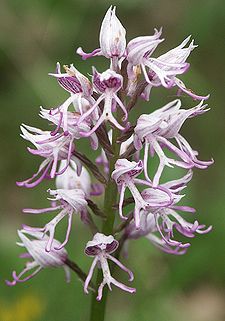Monkey orchid
| Monkey orchid | ||||||||||||
|---|---|---|---|---|---|---|---|---|---|---|---|---|

Monkey orchid ( Orchis simia ) |
||||||||||||
| Systematics | ||||||||||||
|
||||||||||||
| Scientific name | ||||||||||||
| Orchis simia | ||||||||||||
| Lam. |
The Monkey orchid ( orchis simia ) is a plant from the genus of orchids ( orchis ) within the family of orchid (Orchidaceae).
description
The monkey orchid is a perennial , herbaceous plant that reaches heights of 20 to 45 centimeters. The two to five leaves arranged in a rosette are unspotted and up to 20 centimeters long.
The flowering period extends from mid-April to the end of May. The oval inflorescence is densely flowered. Flowering from top to bottom is typical of this species . The hermaphrodite flowers are zygomorphic and threefold. Sepals and petals form a helmet, whitish-pink on the outside and purple-colored dots on the inside. The lip is 15 to 20 millimeters long, clearly three-lobed, the middle lobe deeply divided into two with a short appendage in the middle. Lateral lobes and tip of the middle lobe very narrow, light to strong pink in color. Center of the lip whitish with fine dots. Spur cylindrical, curved downwards. There are pure white flowering or almost pure white flowering specimens.
The number of chromosomes is 2n = 42.
Occurrence and endangerment
The monkey marsh orchid occurs mainly in the Mediterranean area, there are also isolated occurrences in western and central Europe , Asia Minor , Iran , the Caucasus and North Africa .
In Central Europe it occurs very rarely in the extreme southwest at the Burgundian Gate, in the Upper Rhine Valley (at the Kaiserstuhl), in Upper Alsace and in the extreme southwest of Switzerland . At its locations it sometimes forms smaller, very loose and mostly poor populations. In Germany it can only be found in the warmer regions, mainly along the Rhine . In Switzerland, deposits are found in the cantons of Geneva and Vaud . The tendency to spread, as it has been observed with the buck's belt tongue and various domestic Ragwurzen, can only be recognized in the beginning with this species.
The monkey orchid thrives best on lime-rich , dry, humus-rich , deep loam or loess soils . It settles in areas with the warmest climate in Central Europe, dry grass , light shrubbery and light dry forests . It is a species of the Mesobrometum from the Mesobromion association. According to Baumann and Künkele , the species has the following altitude limits in the Alpine countries: Germany 115–640 meters, France 0–1400 meters, Switzerland 200–625 meters, Italy 70–1800 meters, Slovenia 20–1028 meters. In Europe the limits are between 0 and 1800 meters above sea level.
natural reserve
Orchis simia is endangered due to its rarity, especially in its northern range.
Systematics and taxonomy
Subspecies
One can distinguish the following subspecies:
- Orchis simia subsp. simia : It occurs from Europe to Iran and from northern Algeria to northwestern Tunisia.
- Orchis simia subsp. taubertiana (B. Baumann & H.Baumann) Kreutz (Syn .: Orchis taubertiana B. Baumann & H.Baumann ): It occurs in northeastern Libya.
Hybrids
Orchis simia forms hybrids with closely related species such as the orchid orchid ( Orchis militaris ). Hybrids with this species are difficult to identify. The shape of the flower is very similar to that of the monkey orchid. A sure sign of a hybrid is that it blossoms from the bottom up. It also hybridizes with the purple orchid ( Orchis purpurea ), the bald spur ( Aceras anthropophorum ) and other species from the Orchis militaris group of shapes (see Orchis ). For example:
- Orchis × angusticruris Franch. = Orchis purpurea × Orchis simia
- Orchis × beyrichii (Rchb. F.) A. Kern. = Orchis militaris × Orchis simia
Taxonomy
Orchis simia was first published in 1779 by Jean-Baptiste de Lamarck . The specific epithet simia is Latin and means monkey or ape, since the flowers actually look like small, upright monkeys.
Picture gallery
Orchis simia in Orjen , Montenegro
swell
Individual evidence
- ^ Monkey orchid. In: FloraWeb.de.
- ↑ a b Erich Oberdorfer : Plant-sociological excursion flora for Germany and neighboring areas . With the collaboration of Angelika Schwabe and Theo Müller. 8th, heavily revised and expanded edition. Eugen Ulmer, Stuttgart (Hohenheim) 2001, ISBN 3-8001-3131-5 , pp. 280 .
- ↑ a b c Dietmar Aichele, Heinz-Werner Schwegler: The flowering plants of Central Europe . 2nd Edition. tape 5 : Swan flowers to duckweed plants . Franckh-Kosmos, Stuttgart 2000, ISBN 3-440-08048-X .
- ↑ a b Helmut Baumann , Siegfried Künkele : "Orchidaceae". In Oskar Sebald u. a .: The fern and flowering plants of Baden-Württemberg. 1st edition Volume 8, page 383. Verlag Eugen Ulmer, Stuttgart 1998. ISBN 3-8001-3359-8
- ↑ a b c Rafaël Govaerts (Ed.): Orchis simia. In: World Checklist of Selected Plant Families (WCSP) - The Board of Trustees of the Royal Botanic Gardens, Kew . Retrieved December 20, 2016.
Web links
- Monkey orchid . In: BiolFlor, the database of biological-ecological characteristics of the flora of Germany.
- Profile and distribution map for Bavaria . In: Botanical Information Hub of Bavaria .
- Thomas Meyer: Data sheet with identification key and photos at Flora-de: Flora von Deutschland (old name of the website: Flowers in Swabia )
- Switzerland (AGEO: Orchis simia )
- Distribution maps
- Distribution map for Germany. In: Floraweb .
- Switzerland (AGEO)






